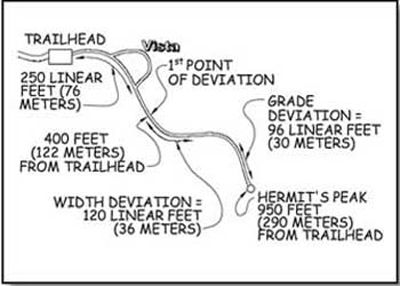Step 4: Calculate Cumulative Deviation Percentage
This final step addresses the suggested objective criteria for identifying when extreme or numerous environmental barriers allow the use of General Exception 2. These barriers are defined in the five limiting factors in FSTAG, section 7.2.2.1.
Design Tip
Apply the process.
Figure 145 helps illustrate how to apply the process by calculating cumulative deviations and considering a prominent feature. The drawing shows that:
-
Deviations occur on more than 15 percent of the trail because 15 percent of 950 feet equals 142.5 feet (15 percent of 290 meters equals 43.5 meters), but the deviations total 216 feet (66 meters).
-
The trail does not have to comply with the guidelines.
-
The first point of deviation occurs 400 feet (122 meters) from the trailhead and the vista is only 250 feet (76 meters) from the trailhead. It may be appropriate to construct the trail in compliance with the guidelines from the trailhead to the vista.

Figure 145—This trail schematic illustrates how to determine where the trail must comply with Forest Service Trail Accessibility Guidelines.
Add the measurements of permitted deviations from step 3. If these deviations occur on 15 percent or more of the total trail length, FSTAG doesn't apply to the trail. Figure 146 shows step 4.

Figure 146—Step 4 of the Forest Service Trail Accessibility Guidelines implementation process. (For a larger image please click here.)

User Comments/Questions
Add Comment/Question